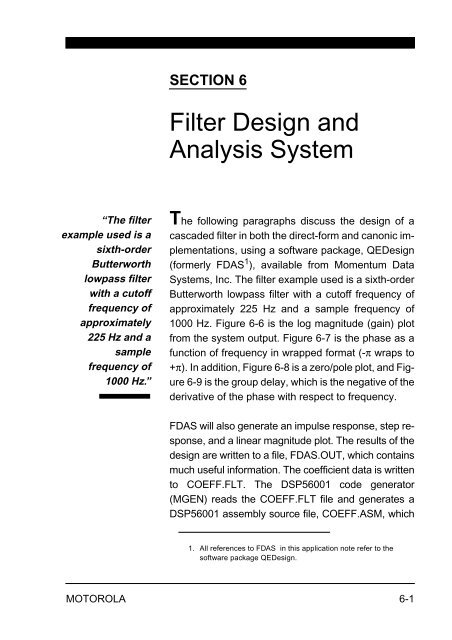Implementing IIR/FIR Filters
Implementing IIR/FIR Filters
Implementing IIR/FIR Filters
You also want an ePaper? Increase the reach of your titles
YUMPU automatically turns print PDFs into web optimized ePapers that Google loves.
“The filter<br />
example used is a<br />
sixth-order<br />
Butterworth<br />
lowpass filter<br />
with a cutoff<br />
frequency of<br />
approximately<br />
225 Hz and a<br />
sample<br />
frequency of<br />
1000 Hz.”<br />
SECTION 6<br />
Filter Design and<br />
Analysis System<br />
The following paragraphs discuss the design of a<br />
cascaded filter in both the direct-form and canonic implementations,<br />
using a software package, QEDesign<br />
(formerly FDAS 1 ), available from Momentum Data<br />
Systems, Inc. The filter example used is a sixth-order<br />
Butterworth lowpass filter with a cutoff frequency of<br />
approximately 225 Hz and a sample frequency of<br />
1000 Hz. Figure 6-6 is the log magnitude (gain) plot<br />
from the system output. Figure 6-7 is the phase as a<br />
function of frequency in wrapped format (-π wraps to<br />
+π). In addition, Figure 6-8 is a zero/pole plot, and Figure<br />
6-9 is the group delay, which is the negative of the<br />
derivative of the phase with respect to frequency.<br />
FDAS will also generate an impulse response, step response,<br />
and a linear magnitude plot. The results of the<br />
design are written to a file, FDAS.OUT, which contains<br />
much useful information. The coefficient data is written<br />
to COEFF.FLT. The DSP56001 code generator<br />
(MGEN) reads the COEFF.FLT file and generates a<br />
DSP56001 assembly source file, COEFF.ASM, which<br />
1. All references to FDAS in this application note refer to the<br />
software package QEDesign.<br />
MOTOROLA 6-1
















